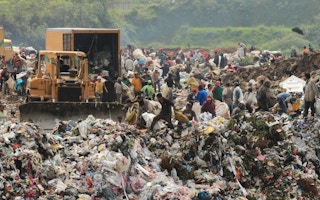Ocean trash and plastic waste are among the most fashionable items on the news agenda today, especially when found in the stomachs of dead whales or ingested by humans.
To continue reading, subscribe to Eco‑Business.
There's something for everyone. We offer a range of subscription plans.
- Access our stories and receive our Insights Weekly newsletter with the free EB Member plan.
- Unlock unlimited access to our content and archive with EB Circle.
- Publish your content with EB Premium.
What has yet to capture the public imagination in the same way, is the environmental cost of what we wear daily.
The stark reality is this: The fashion industry accounts for 10 per cent of carbon emissions today, more than shipping and aviation combined. “If there is no disruption in the way we produce, use and recycle apparel, by 2050, it is projected that the number will be 26 per cent,” said Ariel Muller, Asia Pacific Managing Director of non-profit Forum for the Future, at a session on how the fashion industry can move towards a circular business model at the Ecosperity conference in Singapore in June.
An estimated US$500 billion is lost every year from clothing being hardly worn and rarely recycled. Every second, the equivalent of one garbage truck of textiles is landfilled or burned.
In its move towards the circular economy, it makes sense for the fashion industry to start in Asia.
The US$1.3 trillion clothing industry, which employs 300 million people from production to retail, consumes about 98 million tonnes of oil, fertiliser, chemicals and dye, as well as 93 billion cubic metres of water annually. With China, India, Bangladesh and Vietnam among the world’s largest garment exporters, Asia is the beating heart of fashion supply chains.
For some brands, sustainability is a no-brainer. Swedish fast fashion giant H&M has pledged to use 100 per cent recycled or sustainable-source materials by 2030 and sees a strong business case for going circular.
According to Harsha Vardhan, H&M’s Global Environment Manager, Production, the waste that goes to landfill is a missed opportunity. “It is a cheap resource, but a very high quality resource if you know how to use it,” he said.
“On one hand, resources are going to the landfills, on the other hand, we are predicting [resource] scarcity in the future. There’s a big business case within the company [to go circular],” said Harsha.
Breaking with the new and shiny
Consumers play a role in how quickly the fashion industry changes. Trash is not traditionally seen as treasure, and experts highlighted the uphill task to change consumers’ longstanding preference for novely.
Asian consumers are a huge—and growing—market. According to a study by industry publication The Business of Fashion and the consulting firm McKinsey, China will become the largest fashion market this year. Its middle class is projected to reach 700 million by 2020, giving rise to a new consumer class with considerable buying power.
“There is indeed a deep-seated consumer preference in Asia for the new, bright and shiny, and we must change that,” Edwin Keh, Chief Executive Officer of The Hong Kong Research Institute of Textiles and Apparel (HKRITA), told Eco-Business on the sidelines at Ecosperity.
“Asia has a young population, and many people are able to consume freely for the first time. As such, they see quality and value associated with new materials. At the same time, traditional recycling methods have required consumers to compromise on looks and hand feel, therefore making the problem worse,” said Keh.
Arthur Huang, Chief Executive and Founder of upcycling firm Miniwiz, agreed. “We are closer to trash as a region than say Europe or America. There’s trash that’s being shipped in and dumped, and there’s trash that is generated here as well. We see rubbish as dirty, not luxurious; it’s a world we don’t want to be in. We feel that it’s [beneath] us.”
Clean and sleek images in advertising—“it’s all leather or luxurious fabrics like silk”—reinforce existing notions.
“We must bridge that gap. Recycled materials and products, and the recycler, need to be seen as sexy,” said Huang.
For him, the answer so far has been to work with the world’s top lifestyle tastemakers—from brands and the world’s top designers to celebrities. “Image-making brands are the ones who dictate desired lifestyles. We must mutate how they deal with and communicate wastefulness and sustainability. Basically, start with the cool kids.”
An example is Miniwiz’s collaboration with sportswear firm Nike.
Invited to create an Air Max 1 shoe in 2017, Huang not only incorporated recycled materials into the EVA foam midsole and used Nike’s proprietary Flyknit technology—which is more environmentally sustainable than traditional sports footwear manufacturing methods—but also considered the wider ecosystem.
For packaging, he came up with an “Air Bag”, made from 100 per cent recycled polypropylene, each the result of recycling 180 disposable coffee cup lids. The structured bags could be stacked, replacing traditional palettes used in the transportation process, and could be arranged into an in-store installation.
Scale up fast
Even if trash becomes fashionable and Asian consumers embrace the idea of alternative materials, the industry must not focus on recyclability as a selling point, Huang said.
“People are more practical in Asia; we cannot sell them conceptual ideas,” he said. “The messaging should not be focused on trash but on showing, first of all, that something beautiful and functional can come out of it.”
With scientists warning that the world only has about 12 years before experiencing the worst effects of a hotter planet, solutions and new business models must be scaled up quickly.
“We simply need to scale as fast as possible. Test products in the marketplace even before they are ideal,” Keh said.
HKRITA’s research focuses on shorter and less energy intensive recycling methods. “We aim to recycle fibre to fibre and garment to garment. And using heat and pressure to separate and reprocess material means less damage to the material, less energy in the reprocessing, and no new chemical waste stream being generated,” he said.
Huang is also looking at one of Miniwiz’s innovations, the Trashpresso mobile recycling machine, to encourage more people to recycle. “We want to enable people to take action with a new type of infrastructure,” said Huang.
By decentralising recycling—bringing the process on-site to where the resource is found—contamination and transportation is minimised. This not only reduces the carbon footprint, but conveys the message that recycling need not be complicated, Huang said.

Upcycling company Miniwiz’s mini Trashpresso machine. Image: Miniwiz/Facebook
After showcasing his company’s mini Trashpresso machine in Europe and China, Huang recently brought it to Singapore. Consisting of a 12-metre container housing a solid-waste processing line, the Trashpresso compacts the recycling process into three steps: reducing the size of the plastic waste, purification and reshaping. The result is usable consumer products such as coasters, bowls and cups, in just four minutes.
Going circular: The T&Cs
Miniwiz pairs the latest technology with artificial intelligence (AI) and data to give the scalability—and not to mention, the sexiness—of recycling another boost.
“For example, we use camera technology and a robust materials data bank to identify the materials presented for recycling. Then, using AI, the machine will know to process the trash using the correct level of heat and pressure,” Huang explained. “Data will power recycling in the future.”
AI, data and research will play a similarly crucial role at an earlier stage to reduce waste and consumption, said Keh.
“AI and big data are tools we can use to match demand to supply, therefore reducing waste and unsellable inventory,” he said. “As we learn to use these tools better, and as we develop new tools—for example, we just completed a project to more accurately predict colour sales trends using social media data—we should be able to use the information we have to predict demand, make more accurate forecasts and inventory goods better.”
Collaboration among players such as brands, designers, manufacturers and scientists is key in the push towards circular fashion, said H&M’s Harsha. “The whole industry has to work together to find solutions. When we work together, that’s when we can scale,” he said.












